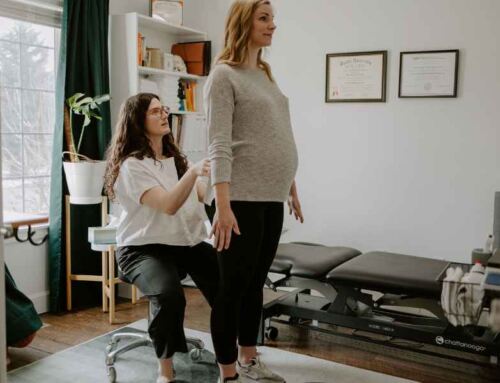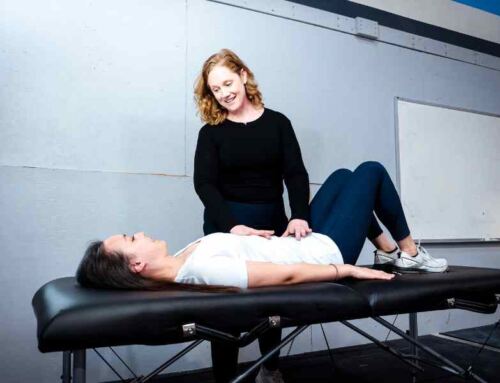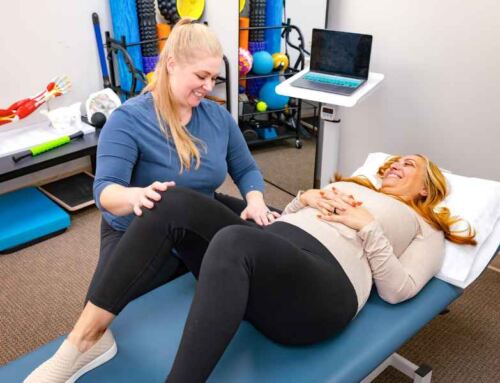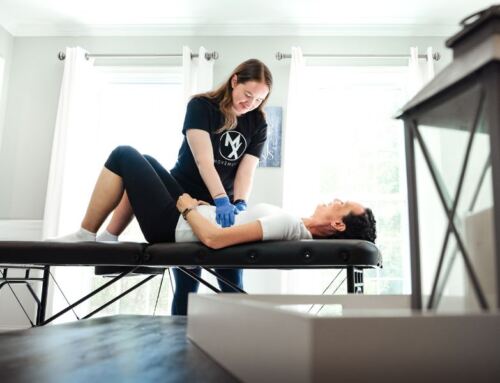Ready or Not? A Guide to Postpartum Return to Running
As a new mom, you’re eager to get back to your running routine. But how soon is too soon? It can be difficult to tell what is a normal pain or symptom of postpartum life and when you should seek further treatment. This post will help you gain confidence in whether or not the decision to return to impact activity is right for you. Are you experiencing knee pain, leaking with sneezing, or pain with walking and daily activities? Use this guide to help you decide if you are ready (or not!) to return to the beautiful feeling of lacing up and heading outside.
The Postpartum Running Dilemma
If you’ve ever met a runner, you know that telling them not to run may not be the best way to get them to rest. Runners want to run!
When it comes to returning to running postpartum, should moms start running immediately after their six-week check-up, regardless of readiness?
Luckily, more and more research has been coming out in the last five years that can help guide clinicians and patients in answering this question (Goom et al, 2019). In fact, a general guideline is to wait until 12 weeks postpartum prior to returning to high impact activity. This is to allow the pelvic floor musculature adequate time to recover as well as build the strength necessary to accommodate impact.
If you decide to return to running when you are symptomatic (such as leaking urine or in pain), then it could actually worsen your symptoms over time. In fact, a more recent study by Christopher et al. (2021) aimed at identifying risk factors for postpartum pain when returning to running highlights an often-overlooked factor: fatigue! Fatigue (such as with lack of sleep…) has been associated with increased risk of pain with postpartum running. Pelvic floor symptoms/ strength, overall strength, running experience level, and fatigue are all important components of creating a return to run plan that is appropriate for you!

Signs Your Body Might Not Be Ready
Before lacing up your running shoes, it’s crucial to ensure your body is prepared.
Here are signs that your pelvic floor might need further evaluation by a pelvic floor physical therapist:
- Heaviness/bulging in the vaginal area
- Urinary or fecal incontinence
- Noticeable dome along the midline of the abdomen (sign of diastasis recti)
- Low back pain/SI pain/pubic bone pain
- Increased blood loss beyond 8 weeks postnatal that is not linked to the menstrual cycle (follow up with your OBGYN)
If you don’t have any of these symptoms on a day-to-day basis, you can start thinking about next steps, but don’t pass GO just yet!
Preparing Your Body for Running
Other things we want to consider are whether our core and lower extremity have returned to a strength appropriate for stabilizing the body during running.
Here are some activity goals to aim for to determine how your body is managing impact:
- Walk for 30 minutes
- Single leg balance for 10 seconds: Standing on the right foot and then the left foot for at least ten seconds each without significant ‘wobbles’ or falling
- Single leg squat x 10 repetitions each side: No piston squats required! but you should be able to stand on one leg while balancing and perform small bends of the knee without pain or falling
- Jog in place for 1 minute: Jogging in place for one minute without pain or pelvic floor symptoms is a good sign that your body is managing some amount of impact
- Forward bounds x 10 repetitions: Bounding forward from one foot to the next in a slow and controlled manner without loss of balance
- Hop in place x 10 repetitions each side: Hop in place on one lower extremity while maintaining balance
- Single leg ‘running man’ x 10 repetitions each side: Starting position: balancing on left lower extremity, right hip at a 90 degree angle; rock trunk forward while right foot reaches back and then return to an upright position. Perform without loss of balance and then attempt on the other side!
Below are some exercises that are an important indication of lumbopelvic strength and you want to aim for performing at least 20 repetitions:
- Single leg calf raise: standing on one leg and using table for balance if needed, go up and down on toes (like a ballerina) 20 times
- Single leg bridge: lying on your back with knees bent, maintain one foot planted on ground and opposite foot elevated off ground. Press up through the planted foot to lift buttocks off ground. You should be able to do this without low back pain as well as rotation in the hips when you lift off the ground.
- Single leg sit to stand: while seated in a chair, try standing up only on one of your legs (do not use your hands!). Perform 20 and repeat on the opposite leg.
- Side lying abduction: lying on your side with your legs stacked and in line with your pelvis, lift your top leg up and down. Make sure you keep your feet in line with your pelvis (and not forward).
You should be able to complete these exercises without vaginal heaviness/bulging, urinary/ fecal incontinence, doming along midline, or musculoskeletal pain (such as low back, hips, knees, pubic bone). These symptoms are worth investigating further with the help of a physical therapist to ensure they do not lead to an injury that would require you to step back from your progress!

Pelvic Floor Strength Goals
In addition to lower extremity strength, we want to consider whether the pelvic floor muscles are ready. You might have been told by a healthcare provider at some point in your postpartum journey to ‘just do kegels.’ A kegel is a contraction of the pelvic floor musculature and previous providers might have told you to “squeeze like you’re trying not to pass gas” or “pick a marble up with your vagina.”
One protocol you can try to see if your pelvic floor has the endurance needed for long distance running:
- Quick contractions x 10 reps – should be able to contract pelvic floor (and equally important, relax the pelvic floor)
- Long contractions for 8 seconds x 8-12 reps
- 60-second submaximal contraction – be able to hold gentle contraction without feeling like your pelvic floor is quivering trying to maintain a contraction
If you read the above pelvic floor contractions and are thinking, “What on earth?” go see a pelvic floor PT! Did you know that around 40% of women who are told to do Kegels by a healthcare provider aren’t doing them correctly? If you’ve been doing Kegels all day but aren’t sure if you’re doing them correctly OR they have been making your symptoms worse, then STOP doing them! Even one session with a pelvic health PT can give you the confidence to stay on track, especially if you feel like you’re squeezing your stomach, bum, or legs together, which is a great sign it’s time to schedule an appointment. We want to make sure you are confident in how to contract the pelvic floor and strong enough to return to running without symptoms!
Why It Matters
Taking the time to properly prepare your body for running postpartum is crucial for long-term health and fitness. We know that about 30% of women report urinary incontinence at 4 years post-delivery, and anywhere from 20-50% of female athletes experience stress incontinence. If not addressed, these symptoms could worsen over time, potentially leading to more serious pelvic floor issues and impacting your ability to enjoy running and other physical activities.
Conclusion
Returning to running after having a baby is an exciting milestone, but it’s important to approach it safely and patiently. By listening to your body, following these guidelines, and seeking professional help when needed, you can set yourself up for a successful and enjoyable return to running.
Remember, every woman’s postpartum journey is unique – honor your body’s needs and don’t hesitate to consult with a pelvic floor physical therapist or your healthcare provider if you have any concerns.
References
- Bump, R.C., Hurt, W.G., Fantl, J.A., & Wyman, J.F. (1991). Assessment of Kegel pelvic muscle exercise performance after brief verbal instruction. American Journal of Obstetrics & Gynecology, 165 (2), 322-329
- Christopher, Shefali & Cook, Chad & Snodgrass, Suzanne. (2021). What are the biopsychosocial risk factors associated with pain in postpartum runners? Development of a clinical decision tool. PLOS ONE. 16. e0255383. 10.1371/journal.pone.0255383.
- Goom, Tom & Donnelly, Grainne & Brockwell, Emma. (2019). Returning to running postnatal – guidelines for medical, health and fitness professionals managing this population. 10.13140/RG.2.2.35256.90880/2.
- Nygaard, I.E., Thompson, F.L.., Svengalis, S.L., & Albright, J.P. (1994). Urinary Incontinence in Elite Nulliparous Athletes. Obstetrics & Gynecology, 84(2), 183-187.
- Nygaard, I.E., DeLancey, J.O.L, Arnsdorf, L., & Murphy, E. (1990). Exercise and Incontinence. Obstetrics & Gynecology, 75 (5), 848-851
- Poswiata, A., Socha, T., Opara, J. (2014). Prevalence of Stress Urinary Incontinence in Elite Female Endurance Athletes. J Hum Kinet. 2014 Dec 9; 44: 91–96 Published online 2014 Dec 30. doi:10.2478/hukin-2014-0114 PMCID: PMC4327384.







